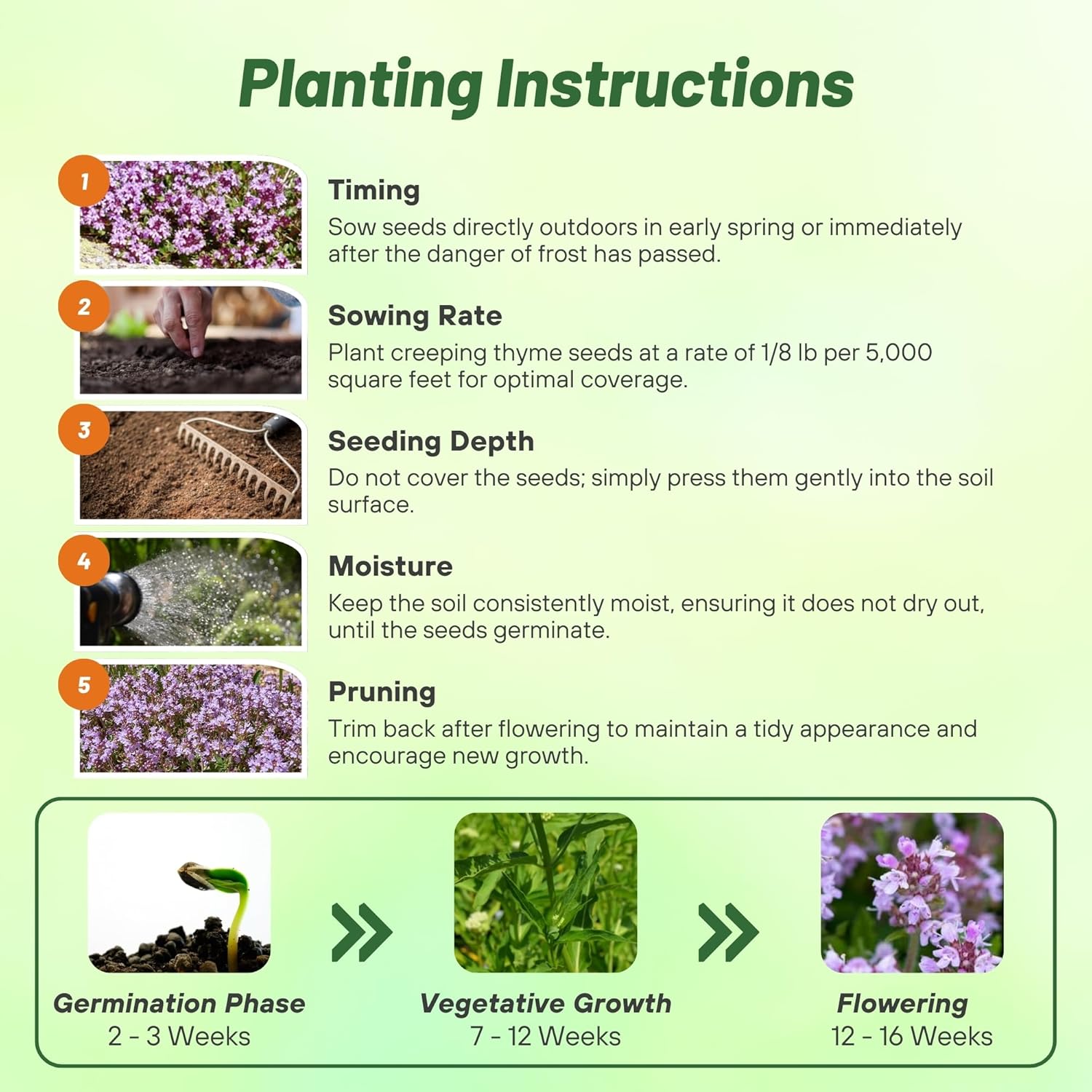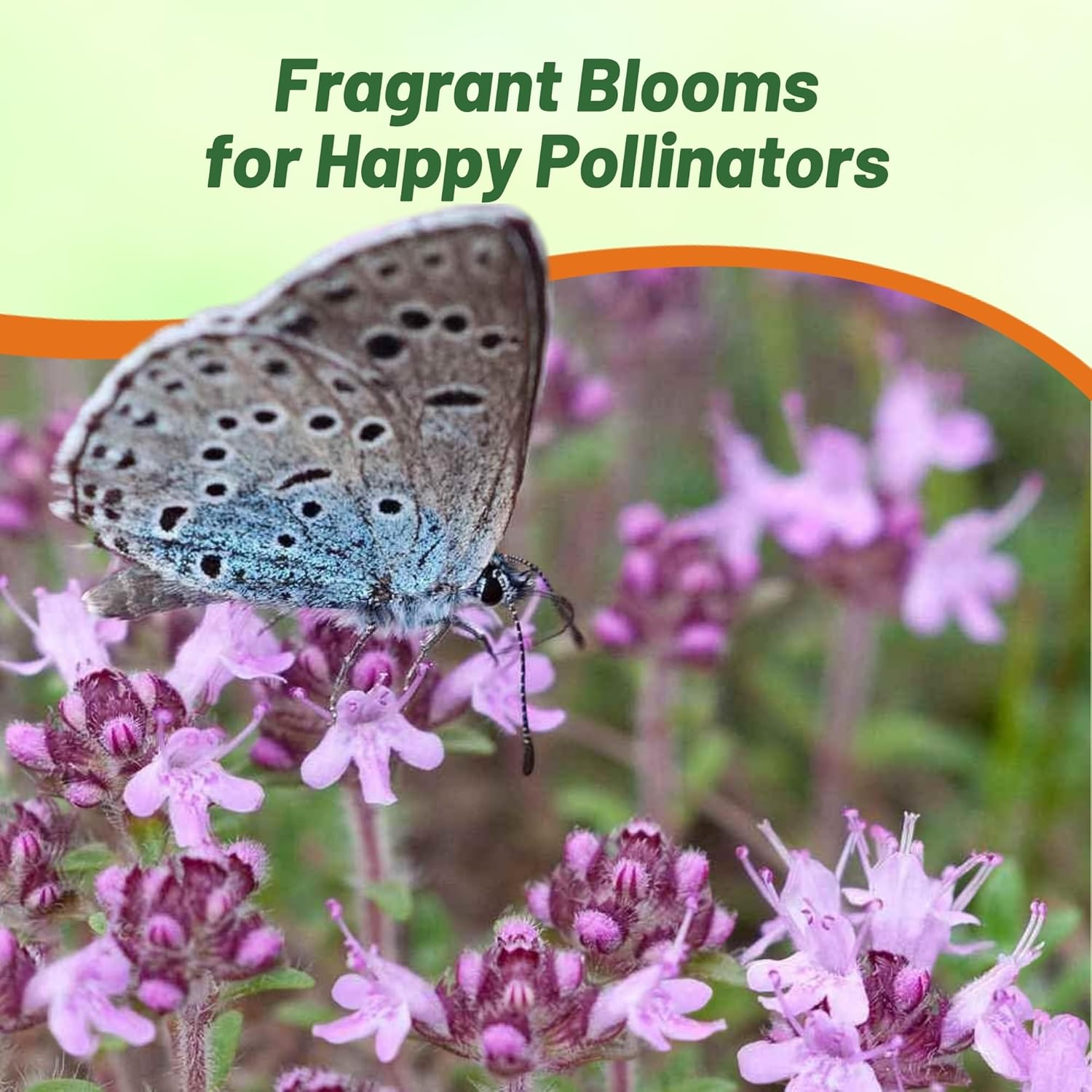







Creeping Thyme Seeds - Serpyllum
About...
Creeping Thyme (Thymus Serpyllum) - Would you like a perennial, drought tolerant ground cover plant that is an evergreen and very little maintenance? Look no further than Thymus Serpyllum seeds to grow a wonderfully hardy ground cover directly in the garden or border! Just 4 - 6 inches tall, Creeping Thyme ground cover plants are completely covered in 1/4 inch bells of purple for the summer months.
MORE CREEPING THYME OPTIONS
Planting Directions
TEMPERATURE
70F
AVERAGE GERM TIME
14 - 21 days
LIGHT REQUIRED
Yes
DEPTH
Do not cover the seed but press into the soil
SOWING RATE
Plant creeping thyme seed at 1/8 lb per 5,000 square feet
MOISTURE
Keep seeds moist until germination
PLANT SPACING
6 - 12 inches









Creeping Thyme (Thymus Serpyllum) - Would you like a perennial, drought tolerant ground cover plant that is an evergreen and very little maintenance? Look no further than Thymus Serpyllum seeds to grow a wonderfully hardy ground cover directly in the garden or border! Just 4 - 6 inches tall, Creeping Thyme ground cover plants are completely covered in 1/4 inch bells of carmine-pink for months on end. Bees and butterflies love it and so will you! Creeping Thyme will spread to 18 inches in width in no time at all. Grow in well-drained neutal to alkaline soil in full sun. After flowering, cut vigorous thymes back hard to maintain compactness. In an alpine house, use equal parts loam, leaf mould, and grit.
Approximately 2,700,000 seeds per pound.
Common Questions
Can I grow thyme indoors?
Yes, thyme is fine grown indoors in a sunny location.
How can I use thyme as a companion plant?
Plant thyme alongside members of the cabbage family to help repel insects that target those plants. Thyme can be grown as a companion for eggplant, onion, potato, sage, and tomato, enhancing their flavor and health while keeping pests at bay.
My thyme is getting woody, how can I rejuvenate it?
Cut out any dead or damaged stems in late winter or early spring. In summer, trim the plant back by one third of its height if it looks leggy. Cut back overgrown stems to the desired height to keep a mounded shape.
How can I make a thyme topiary?
Prune the side shoots to encourage vertical growth. Stake the plant and hold it to the stake with soft ties. Let it grow in full sun with plenty of water and when the plant is about 2 feet tall, snip the tops to encourage side shoots. Strip the bottom two thirds of the stem of the branches and leave the top third for shaping. Continue to pinch off the growing tips to maintain a full dense top.
What are some ways creeping thyme is used in the landscape?
Creeping thyme makes for excellent ground covers, filler for stepping stones, in rock gardens, garden edging plants, garden pathways and in containers.
Do I need to cut back my plants?
Yes, to maintain a neat appearance they will need to be cut back when you notice them looking a bit wild.
Planting Directions
TEMPERATURE
68F
AVERAGE GERM TIME
21 - 28 days
LIGHT REQUIRED
Yes
DEPTH
Do not cover the seed but tightly press into the earth
SOWING RATE
500 seeds covers 10 square feet
MOISTURE
Keep seeds moist until germination
PLANT SPACING
12 inches









Creeping Thyme (Thymus Serpyllum Magic Carpet) - If you have a stepping stone path or a flagstone patio, growing Magic Carpet seeds is a great way to add a beautiful, low-growing, drought resistant thyme to the walkway and patio crevices. Creeping thyme ground cover is only 2 - 4 inches high, and it spreads and flowers for most of the summer. Magic Carpet thyme is perfect for edging the flower border, xeriscape rock gardens, walkways, patios and in containers. The ground cover plants are full of tiny pink clusters of blooms that are attractive to butterflies. The groundcover is lemen-scented, and it is a maintenance free, hardy plant that will give years of beauty and enjoyment.
Common Questions
Can I grow thyme indoors?
Yes, thyme is fine grown indoors in a sunny location.
How can I use thyme as a companion plant?
Plant thyme alongside members of the cabbage family to help repel insects that target those plants. Thyme can be grown as a companion for eggplant, onion, potato, sage, and tomato, enhancing their flavor and health while keeping pests at bay.
My thyme is getting woody, how can I rejuvenate it?
Cut out any dead or damaged stems in late winter or early spring. In summer, trim the plant back by one third of its height if it looks leggy. Cut back overgrown stems to the desired height to keep a mounded shape.
How can I make a thyme topiary?
Prune the side shoots to encourage vertical growth. Stake the plant and hold it to the stake with soft ties. Let it grow in full sun with plenty of water and when the plant is about 2 feet tall, snip the tops to encourage side shoots. Strip the bottom two thirds of the stem of the branches and leave the top third for shaping. Continue to pinch off the growing tips to maintain a full dense top.
What are some ways creeping thyme is used in the landscape?
Creeping thyme makes for excellent ground covers, filler for stepping stones, in rock gardens, garden edging plants, garden pathways and in containers.
Do I need to cut back my plants?
Yes, to maintain a neat appearance they will need to be cut back when you notice them looking a bit wild.
Planting Directions
TEMPERATURE
70F
AVERAGE GERM TIME
14 - 21 days
LIGHT REQUIRED
Yes
DEPTH
Do not cover the seed but press into the soil
SOWING RATE
5000 seeds covers approximately 100 square feet
MOISTURE
Keep seeds moist until germination
PLANT SPACING
12 inches









Creeping Thyme (Thymus Serpyllum Mother of Thyme) - Edge the borders of your herb, flower or vegetable garden with Mother of Thyme seed. It is low-growing, drought tolerant and spreading, with spikes of lavender bloom clusters. Mother of Thyme blooms all summer long, and the foliage is an evergreen in most locations. Easy-to-grow from Creeping Thyme seeds, this creeping plant is also used between paving-stones or bricks in walk ways where water conservation is desired.
Common Questions
Can I grow thyme indoors?
Yes, thyme is fine grown indoors in a sunny location.
How can I use thyme as a companion plant?
Plant thyme alongside members of the cabbage family to help repel insects that target those plants. Thyme can be grown as a companion for eggplant, onion, potato, sage, and tomato, enhancing their flavor and health while keeping pests at bay.
My thyme is getting woody, how can I rejuvenate it?
Cut out any dead or damaged stems in late winter or early spring. In summer, trim the plant back by one third of its height if it looks leggy. Cut back overgrown stems to the desired height to keep a mounded shape.
How can I make a thyme topiary?
Prune the side shoots to encourage vertical growth. Stake the plant and hold it to the stake with soft ties. Let it grow in full sun with plenty of water and when the plant is about 2 feet tall, snip the tops to encourage side shoots. Strip the bottom two thirds of the stem of the branches and leave the top third for shaping. Continue to pinch off the growing tips to maintain a full dense top.
What are some ways creeping thyme is used in the landscape?
Creeping thyme makes for excellent ground covers, filler for stepping stones, in rock gardens, garden edging plants, garden pathways and in containers.
Do I need to cut back my plants?
Yes, to maintain a neat appearance they will need to be cut back when you notice them looking a bit wild.
Planting Directions
TEMPERATURE
70F
AVERAGE GERM TIME
14 - 21 days
LIGHT REQUIRED
Yes
DEPTH
Do not cover the seed but press into the soil
SOIL TYPE
Well-drained, pH 5.8 - 6.8
SOWING RATE
Plant creeping thyme seed at 1/8 lb per 5,000 square feet
MOISTURE
Keep seeds moist until germination









Wild Thyme (Thymus Pulegioides) - Wild Thyme (also known as lemon thyme, larger thyme, and broad-leaf thyme) is a fragrant, spreading, drought tolerant perennial that is native to northwest Europe. Plants form dense mats that create an excellent ground-cover. Plants are 6-12 inches tall, and the lavender flowers appear just above the foliage. As with many species in the mint family, the flowers of Wild Thyme are very attractive to honey bees and wild bees. Parts of the Wild Thyme flower are used medicinally. It can be taken to treat respiratory problems such as coughs, bronchitis, and swollen airways. It has also been used to treat kidney and bladder problems, poor blood circulation, bad cholesterol, and colic.
Approximately 2,700,000 seeds per pound.
Common Questions
Can I grow thyme indoors?
Yes, thyme is fine grown indoors in a sunny location.
How can I use thyme as a companion plant?
Plant thyme alongside members of the cabbage family to help repel insects that target those plants. Thyme can be grown as a companion for eggplant, onion, potato, sage, and tomato, enhancing their flavor and health while keeping pests at bay.
My thyme is getting woody, how can I rejuvenate it?
Cut out any dead or damaged stems in late winter or early spring. In summer, trim the plant back by one third of its height if it looks leggy. Cut back overgrown stems to the desired height to keep a mounded shape.
How can I make a thyme topiary?
Prune the side shoots to encourage vertical growth. Stake the plant and hold it to the stake with soft ties. Let it grow in full sun with plenty of water and when the plant is about 2 feet tall, snip the tops to encourage side shoots. Strip the bottom two thirds of the stem of the branches and leave the top third for shaping. Continue to pinch off the growing tips to maintain a full dense top.
What are some ways creeping thyme is used in the landscape?
Creeping thyme makes for excellent ground covers, filler for stepping stones, in rock gardens, garden edging plants, garden pathways and in containers.
Do I need to cut back my plants?
Yes, to maintain a neat appearance they will need to be cut back when you notice them looking a bit wild.
































